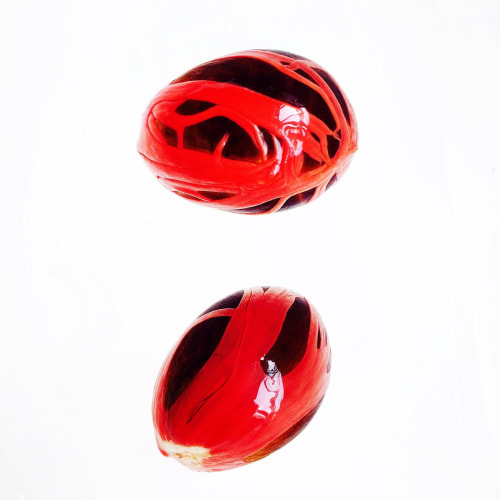When I was a little girl, Christmas was one of the most exciting times of the year, if not the most exciting of them all...
Christmas was magical, it was cosy and it was always very cold. Sometimes snowing, sometimes not. So we would eat hot food to keep up the body temperature.
The kids would normally have sweet snacks like æbleskiver (a ball-round pancake) with jam and sugar and the parents would drink lots of Glögg, gløgg, glögi (nordic mulled wine). Most of the time, they would not be able to drive back home after a few glasses.
I don't remember drinking the mulled wine when young, of course, but I do remember the SMELL! So many exotic spices. Just like from the christmas cookies like Pebernødder and brunkager. Oh, sweet sweet memories.
What a surprise, when I recently found it growing in Singapore. In fact, the whole of busy shopping paradise Orchard Road used to be full of nutmeg plantations back in the 1840's.
The crazy thing is that we called one of these wonderful exotic spices muskatnød (nutmeg), thinking it came from the city Muscat in Oman. In fact, nutmeg never came from Muscat, the nutty story is that clever Arab traders had us all fooled for centuries.
They had discovered the nutmeg tree on a little island called Run Island, as part of Banda Islands in Indonesia. The only place in the world where nutmeg grew natively. So, I guess, they decided to keep the Indonesian island a secret and sold the nutmegs to Venetian traders. The Venetians sold nutmeg on to the rest of Europe, including the nordics, who thought the wonderful spice came from the Middle East.
The spice trade was big business and later in history, many terrible wars were fought over the control of the Banda Islands. In 2015 at Art Stage Singapore, I saw this amazing installation by Indonesia Artist Titarubi called "Imago Mundi".

Art Stage Singapore, 2015 and Imago Mundi Installation by Titarubi.
"In the 16th and 17th centuries, nutmeg was the most desired luxury good in Europe, more valuable than gold. The English and the Dutch engaged inprolonged battles to gain control of the nutmeg industry. Jan Pieterszoon Coen, then newly-appointed Governor-General of the Dutch East India Company, waged a bloody war to enforce Dutch monopoly over the Banda Islands' spice trade, including the massacre and enslavement of the inhabitants in 1621. Most historians believe that the population of the islands was around 15,000 before 1621, but the Dutch brutally massacred all but about 1,000 of them. Thereafter, the Banda Islands were run as a series of plantation estates with imported slaves from Java and other Indonesian islands. The price of nutmeg was kept artificially high by the Dutch, as they voluntarily burnt warehouses full of nutmegs in Amsterdam".
I remember going to Art Stage with my Dutch-Indonesian husband-to-be, Quinten, and he was shocked about the brutality and slaughtering by/of his ancestors. I just fell appalled. Why would anybody do this for a nut?
It turned out that people thought that nutmeg was magical and if you ate or wore it, you would avoid all kinds of illness. Basically, buying yourself immortality. Later, it was discovered that the nut and the mace contained certain aphrodisiac substances. You could get a "high" from nutmeg, even die from overdoses.
I suppose that nut and mace from nutmeg will always bring us a little "high", especially around celebrations. The fruit surrounding the nuts does not contain the toxins. It's eaten raw in Pisa, Italy and candied and juiced in places like Penang, Malaysia and Aceh, Indonesia. It's a wonderful exotic fruit, unlike anything else in its taste.
Looking back at the bloody history, I'm not sure if the original people of that little Run Island had wished that the world would never have discovered the wonders of that little nut. That's the true and pretty nutty story of nutmeg.
Inspiration
- Read more about nutmeg.
- Also see Nparks description about nutmeg.
- How to make Gløgg? The Guardian has a good story here
- How to make Pebernødder? See Marie's Eats English Version here.
Nugmeg in different languages
- Danish: muskatnød
- Swedish: muskot
- Norwegian: muskat
- Finnish: muskottipähkinä
- Chinese: rou dou kou / ron dau kou
- Japanese: hikaya
- Malay: pala / buah pala
- Pinyin: Rou Dou Kou
- Indian: jaiphal / jatipari / jatikosha
- Hindi: Jaayphala / Jayphala / Japhal / Jaephal / Jaiphal
- Spanish: nuez moscada / nuez moscada y macis
- German: die mustanuß / muskatbuam
- Dutch: nootmuskaat / muskaatboom /foelie
- French: muscade / noix muscade / fleur de muscade / macis / muscade et macis
- English: nutmeg / muscade (adapted) / mace / nutmeg and mace
- Latin: Myristica fragrans
Family
See also Pala Hutan (Myristica elliptica) and Pala Bukit (Myristica cinnamomea).
